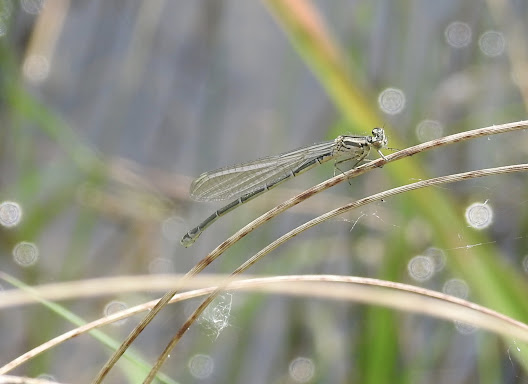So here we are, early May is turning towards mid May and most of the migrant birds are now settled down on their breeding grounds and not planning to move again until about August. As a result I should be suffering from writer's block.
The Sunday visit to Morton Bagot was predictably steady, adding just a briefly singing Reed Warbler to the year list and an ever so distant Hobby as bird of the day. Admittedly a pair of Avocets has reappeared along with a pair of Black-headed Gulls and a Little Egret, but that was about it.
 |
| Avocet and Little Egret |
Thank goodness for insects. Just as the birdlife gets a bit blaah butterflies, moths, and dragonflies step up to do the heavy lifting.
New for the year were a Small Heath (possibly my earliest ever, but I've no intention of checking), numerous Azure Damselflies, a few Large Red Damselflies, and a Four-spotted Chaser.
 |
| Small Heath |
 |
| An immature Azure Damselfly |
 |
| Large Red Damselfly (male) |
 |
| Four-spotted Chaser |
All these insects appear in a predictable sequence through the summer ensuring that interested is maintained until about August (when the birds start migrating again). Hurrah.
And then of course there are moths. About twenty to thirty species of dragonflies and butterflies, but 2000 species of moths, they are the gift that keeps on giving. At Morton Bagot on Sunday most moths are hidden away in daylight, but its still possible to disturb one or two micros. I added two to the year list Common Marble Celypha lacunana, and the tiny Cocksfoot Moth Glyphipterix simpliciella which I thought was going to be something new but was actually common and not even new for the site. However, I did pot a tiny little moth which I took home for further research and discovered it was new to me; a Speckled Grass-miner Elachista rufocinerea.
 |
| Elachista rufocinerea |
Incidentally, for micro moths the "English names" are a relatively new contrivance so most moth-ers don't know what you are talking about until you add the Latin name. That probably includes me.
Finally, to take advantage of the last of the warm spring weather I put my trap out in the garden and managed to attract 38 moths of 27 species. These included eight new for the year plus two which were lifers.
The latter were a Poplar Lutestring (the Warwickshire records are clustered around woodlands bordering Redditch), and a Scalloped Hazel, which the books suggest is common but experience tells me they avoid our garden.
 |
| Poplar Lutestring |
 |
| Scalloped Hazel |
The wind was south-easterly last night and our garden lies about half a mile north-west of a nice stand of Poplars. so there was a bit of a theme going with regard to some other less than frequently seen moths.
A Poplar Hawk-moth was my first since the council chopped down a circle of mature Poplars on an island which is slightly closer to us, so that's since 2019. A Poplar Kitten was only the second for the garden.
 |
| The enormously impressive Poplar Hawk-moth |
 |
| Poplar Kitten |
Another unusual visitor was my first Red Twin-spot Carpet since 2018, although strictly speaking it should be aggregated as Red/Dark Twin-spot Carpet as they can be indistinguishable. Dark Twin-spot is a lot rarer, and is usually in a dark patterned form.
 |
| Red/Dark Twin-spot Carpet |
I could go on, but I think I'll stop there. Suffice to say it was another good moth night.
I thought I recognised your new micro. I believe I had one of those a couple of weeks ago, but pic not great, so County Recorder is not committing himself !!
ReplyDeleteI'll find out in due course what the Warwickshire recorder makes of it🤞
Delete